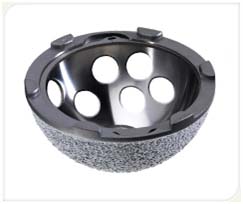Revision hip replacement in India :

Orthopedic Surgery
Why does a hip need to be revised?
Pain is the primary reason for revision. Usually the cause is clear but not always. Hips without an obvious cause for pain in general do not do as well after surgery.
Plastic (polyethylene) wear This is one of the easier revisions where only the plastic insert is changed
Dislocation (instability) means the hip is popping out of place.
Loosening of either the femoral or acetabular component. This usually presents as pain but may be asymptomatic. For this reason, you must have your joint followed up for life as there can be changes on X-ray that indicate that the hip should be revised despite having no symptoms.
Infection usually presents as pain but may present as an acute fever or a general feeling of unwell.
Osteolysis (bone loss) This can occur due to particles being released into the hip joint that result in bone being destroyed
Pain from hardware e.g.. cables or wires causing irritation
Revision Hip Replacement
Revision total hip replacement is performed when the original primary total hip replacement has worn out or loosened in the bone. Revisions are also carried out if the primary hip replacement fails due to recurrent dislocation, infection, fracture or very rarely, ongoing pain and significant leg length discrepancy.
The revision total hip replacement is a more complex procedure, often because there is a reduced amount of bone to place the new total hip into. Extra bone may be required and this is usually received from a bone bank. Bone bank (allograft bone) is safe and has been irradiated to eliminate any chance of disease transmission. There are also artificial bone substitutes that may be used.
Revision total hip replacement takes longer than a standard total hip replacement and has a slightly higher complication rate. The prosthesis may also not last as long as a primary hip replacement. Surgery is usually performed through the same incision but may need some extension.
Surgical Approaches
There are four approaches to the hip and access takes advantage of the muscular planes surrounding the hip joint.
Anterior (front) Approach
The anterior approach has been revitalised for minimally invasive surgery (MIS) — a procedure that We Care India partner surgeon specialises in that can significantly reduce recovery time — when performing a total hip replacement.
Lateral (side) Approaches
The anterolateral approach is the most commonly used approach for total hip replacements.
The direct lateral approach exposes the hip joint by detaching the upper end of the thigh bone (the greater trochanter).
Posterior (rear) Approach
The posterior approach is the second most common approach when performing a total hip replacement.
Approaches for Revision Hip Surgery
The approaches are the same as when performing primary hip replacements but the surgical approach can be extended for increased exposure for what is a more complex procedure.
Advantages
- Relief of pain and restoration of hip function
- Return to a full and active life style
Disadvantages
- Failure of the hip implant over time
- Inherent risks of surgery
Indications
- Revision surgery is required for patients when the hip implant has failed
Contraindications
- Patients who are frail and have severe heart conditions
- The presence of active infection is a contraindication to hip surgery
Possible Complications
- Dislocation : This occurs when the ball of the femoral component is dislocated from the acetabular cup.
- Infection : A bacterial invasion of the hip joint.
- Thromboembolism : Blood clots and migration of the clot to the lungs.
- Leg length discrepancy : Limb length discrepancies.
- Fracture of femur : A crack or split/break of thigh bone.
- Nerve injuries : Stretching, cautery or incision of a nerve.
- Vascular injuries : Penetration or incision of an artery or vein.
- Non union of the greater trochanter : The upper end of the thigh fails to unite following an osteomy.
- Heterotopic ossification : New bone formation where bone is not normally present.
- Stem breakage : A crack or fracture of the femoral stem.
- Loosening : Loosening of the hip joint prostheses.
- Wear : The erosion of the surface of two materials in contact with one another.
- Pseudomembranous colitis : A bowel problem related to antibiotic treatment.
- Anaesthetic complication (Rare.)
- Death (Rare.)
Recovery
The first day most patients will have had their intravenous drip removed.
The physiotherapist will see you after surgery and from then on begin with muscle strengthening and stretching exercises. You will be taught the safe way of getting in and out of bed.
You will learn how to use a support and you will be encouraged to take exercise on a regular basis. By the time of discharge from around 3 to 7 days you will be able to perform all activities unassisted.
You will be able to go home in a car and it may be best to have some help when you return home.
Walking is good for your hip joint and excellent exercise. Non-impact sports are advisable and these include swimming, cycling and golf. Your functional ability will improve rapidly week by week until you are able to drive a car at 6 weeks.
Revision Hip Surgery in Detail
As more primary arthroplasties are performed particularly in young patients to try and attain an improved quality of life the risk of revision surgery increases. The problem with revision surgery is that removal of the hip prosthesis and replacement with a second, third and even fourth artificial joint requires increased technical skills, an array of specialist equipment and bone grafting facilities. These complex operations have a longer operation time, a longer rehabilitation and a higher complication rate. Unfortunately it is not the same as replacing a mechanical part where once the new part is in place the machine continues to perform as if it were new.
The problem lies in the fact that the mechanical components wear and loosen. The loosening of these components within the bony supports is often associated with bone resorption (osteolysis) and the surrounding scaffolding for subsequent hip replacements is weakened.
 Jumbo cups made with cobalt chrome alloy have been the workhorse for revision hip surgery over the past two decades. However, acetabular shells made with porous metals are now being used. The pores in the metal mimic coral and are of a size appropriate for increased bone in-growth. Canine model studies have confirmed rapid bone in-growth and early vascularity.
Jumbo cups made with cobalt chrome alloy have been the workhorse for revision hip surgery over the past two decades. However, acetabular shells made with porous metals are now being used. The pores in the metal mimic coral and are of a size appropriate for increased bone in-growth. Canine model studies have confirmed rapid bone in-growth and early vascularity.
Porous metals are highly bio-compatible and at the same time they are strong, flexible and impart high friction. These metals may be either pure tantalum or pure titanium.
The technological advance in revision femoral stems has reduced the need for bulk and impaction bone grafting. The restoration of bone stock still however remains a primary requirement of revision hip replacement. Modular stems with adjustable necks and offsets and lengths allow for primary fixation using porous and hydroxyapatite coating and screw fixation if necessary.
Revision hip surgery is also performed because of dislocation of the components, subluxation or dislocation of the liner from the acetabular shell, deep infection, surrounding fracture of bone, prosthetic fracture and subsidence of the femoral stem.
The majority of patients present with pain in the region of the hip which often radiates down the thigh into the knee and occasionally into the upper region of the lower leg. The pain may be initiated by movement, for example, when rising from a sitting position, and is often worse at night.
The pain is frequently associated with a decreased functional ability, a limp and possibly a shortened leg on the affected side.
A careful history, clinical and radiological examination will provide your orthopaedic surgeon with the necessary information to confirm the diagnosis.
The patient needs to understand the realistic goals of this type of surgery. Complications are more frequent than with primary hip arthroplasty. There is at least a two-fold increase of sepsis and in general all complications are doubled.
Dislocation can range from 2 – 26% with increase in recurrent instability. With each revision operation the risk of complications increase with nerve injuries ranging from 3 – 8%.
The majority of revision hip operations require restoration or replacement of lost bone which remains a priority at surgery.
Bone grafting procedures may alter the post–operative management and patients may be required to use crutches for prolonged periods. Rehabilitation tends to progress more slowly than after a primary total hip replacement.
India Surgery Revision Hip Replacement, Cost Revision Hip Replacement, Revision Hip Replacement, Repeat Hip Replacement, India Revision, Hip Revision Treatment, India Surgery Tour, Surgery For Revisions, Before Revision Hip Replacement Surgery, Revision Hip Replacement Hospitals, India Hip Pain, Surgery Of Revision Hip Replacement, India Cheap Revision Hip Replacement Surgery, Hip Replacement, Injury, Total Hip Replacement, Hip Revision Surgery, Total Hip Revision, Revision Implants, THR Revision
Revision hip replacement in India India offers information on Revision hip replacement in India in India, Revision hip replacement in India cost India, Revision hip replacement in India hospital in India, Delhi, Mumbai, Chennai, Hyderabad & Bangalore, Revision hip replacement in India Surgeon in India
Modern hip replacement has resulted in huge benefit for patients with arthritic hip disease providing them with reduction of pain, return of function and consequently an improved quality of life. The clinical success of total hip replacement is often taken for granted by the general population.
There is evidence of increased longevity (twenty years or more) with some total joint replacements, but many of these mechanical joints fail at around fifteen years when the hip joint loosens. Revision hip surgery is technically extremely difficult and few orthopaedic surgeons have extensive experience in this field.


 Jumbo cups made with cobalt chrome alloy have been the workhorse for revision hip surgery over the past two decades. However, acetabular shells made with porous metals are now being used. The pores in the metal mimic coral and are of a size appropriate for increased bone in-growth. Canine model studies have confirmed rapid bone in-growth and early vascularity.
Jumbo cups made with cobalt chrome alloy have been the workhorse for revision hip surgery over the past two decades. However, acetabular shells made with porous metals are now being used. The pores in the metal mimic coral and are of a size appropriate for increased bone in-growth. Canine model studies have confirmed rapid bone in-growth and early vascularity.

